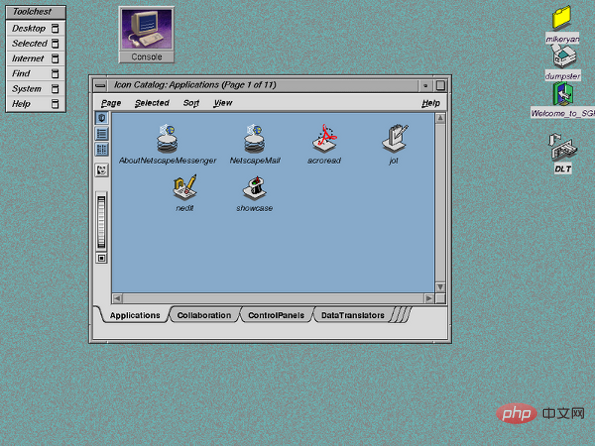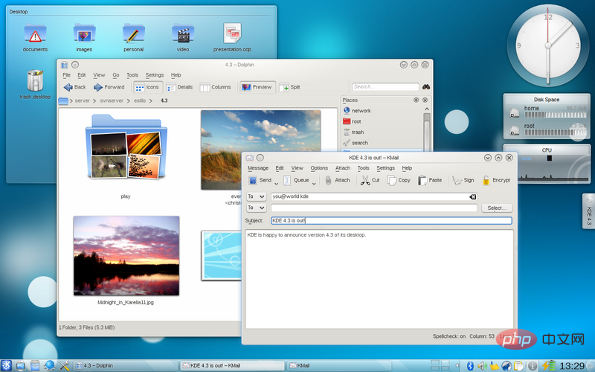 Operation and Maintenance
Operation and Maintenance
 Linux Operation and Maintenance
Linux Operation and Maintenance
 What are the differences between unix and linux
What are the differences between unix and linux
What are the differences between unix and linux
What is the difference between Linux and UNIX operating systems?
UNIX is a copyrighted name, and only large companies are allowed to use the UNIX copyright and name, so IBM AIX and Sun Solaris and HP-UX are all UNIX operating systems. The Open Group holds the UNIX trademark, the industry's trust, and manages the UNIX trademark licensing program.

Most UNIX systems are commercial in nature.
Linux is a UNIX clone
However, if the Portable Operating System Interface (POSIX) standard is considered, then Linux can be considered a UNIX. Quoting from the official Linux kernel readme:
Linux is a Unix clone written from scratch by Linus Torvalds with help from a loose group of hackers on the web. It is designed for POSIX compliance.
However, the "Open Group" disapproves of building "Unix-like" and considers it a misuse of their UNIX trademark.
Linux is just a kernel
Linux is just a kernel. All Linux distributions include GUI system GNU utilities (like cp, mv, ls, date, bash, etc.) Installation and management tools GNU c/c compiler editor (vi) and various applications (like OpenOffice, Firefox) . However, most UNIX operating systems are considered a complete operating system because all operating systems come from a single source or vendor.
As I said before, Linux is just a kernel, Linux distributions make it a complete usable operating system by adding various applications. Most UNIX operating systems come with AZ programs such as editors, compilers, etc. For example, HP-UX or Solaris come with the AZ program.
License and Fees
Linux is free. You can download it from the Internet or redistribute it under the GNU license. The best community support you'll ever see for Linux. Most UNIX-like operating systems are not free (but this is changing rapidly, e.g. OpenSolaris UNIX). However, some Linux distributions (such as Redhat/Novell) offer additional Linux support, consulting, bug fixes, and training for an additional fee.
Easy to use
Linux is considered the most user-friendly UNIX operating system. It can easily install sound cards, flash players and other desktop devices. However, Apple OS X is the most popular UNIX operating system used for desktop use.
Secure Firewall Software
Linux comes with an open-source netfilter/iptables-based firewall tool that protects your servers and desktops from crackers and hackers. UNIX operating systems come with their own firewall products (for example, Solaris UNIX comes with an ipfilter-based firewall), or you need to purchase third-party software, such as Checkpoint UNIX Firewall.
Backup and Recovery Software
UNIX and Linux come with a different set of tools for backing up data to tape and other backup media. However, they all share some common tools such as tar, dump/restore and cpio etc.
File system
Linux supports and uses ext3 or ext4 file system by default.
UNIX comes with various file systems such as jfs, gpfs (AIX), jfs, gpfs (HP-UX), jfs, gpfs (Solaris).
System Management Tools
1.UNIX comes with its own tools on HP-UX, such as SAM.
2.Suse Linux comes with Yast
3.Redhat Linux comes with its own gui tool redhat-config-*.
However, editing text configuration files and typing commands are the most common options for sys management work under UNIX and Linux.
System startup script
Nearly every version of UNIX and Linux comes with system initialization scripts, but they are located in different directories:
HP-UX - /sbin/init.d AIX - /etc/rc.d/init.d Linux - /etc/init.d
End user perspective
For ordinary end users, the difference is not big. They will use the same shell (such as bash or ksh) and other development tools such as Perl or Eclipse development tools.
System administrator perspective
Similarly, the difference between system administrators is not big. However, you may notice various differences when you perform the following operations:
1. Software installer
2. Hardware device name
3. Various management commands or Utilities
4. Software RAID devices and mirrors
5. Logical volume management
6. Package management
7.Patch management
UNIX operating system name
HP-UX IBM AIX Sun Solairs Mac OS X. IRIX
Linux distribution (operating system) name
Redhat Enterprise Linux Fedora Linux Debian Linux Suse Enterprise Linux Ubuntu Linux
FAQ between Linux and UNIX
Both share many common applications, such as:
1.GUI, File and Windows Manager (KDE, Gnome)
2.Shells (ksh, csh, bash)
3. Various office applications, such as OpenOffice.org
4. Development tools (perl, php, python, GNU c/c compiler)
5.Posix interface
UNIX desktop screenshot

Figure 01: UNIX Desktop - IRIX 6.5 Desktop
Linux Desktop Screenshot

Figure 02: Linux KDE Desktop Environment
UNIX and Linux Hardware
Commercial UNIX hardware has more advanced initial boot Options, such as:
Decide how to boot
Check system health
Set hardware parameters, etc.
The PC standard BIOS used by Linux has few of these features. UNIX hardware or servers are quite expensive compared to Linux server systems.
The above is the detailed content of What are the differences between unix and linux. For more information, please follow other related articles on the PHP Chinese website!

Hot AI Tools

Undresser.AI Undress
AI-powered app for creating realistic nude photos

AI Clothes Remover
Online AI tool for removing clothes from photos.

Undress AI Tool
Undress images for free

Clothoff.io
AI clothes remover

Video Face Swap
Swap faces in any video effortlessly with our completely free AI face swap tool!

Hot Article

Hot Tools

Notepad++7.3.1
Easy-to-use and free code editor

SublimeText3 Chinese version
Chinese version, very easy to use

Zend Studio 13.0.1
Powerful PHP integrated development environment

Dreamweaver CS6
Visual web development tools

SublimeText3 Mac version
God-level code editing software (SublimeText3)

Hot Topics
 1387
1387
 52
52
 Key Linux Operations: A Beginner's Guide
Apr 09, 2025 pm 04:09 PM
Key Linux Operations: A Beginner's Guide
Apr 09, 2025 pm 04:09 PM
Linux beginners should master basic operations such as file management, user management and network configuration. 1) File management: Use mkdir, touch, ls, rm, mv, and CP commands. 2) User management: Use useradd, passwd, userdel, and usermod commands. 3) Network configuration: Use ifconfig, echo, and ufw commands. These operations are the basis of Linux system management, and mastering them can effectively manage the system.
 Where to view the logs of Tigervnc on Debian
Apr 13, 2025 am 07:24 AM
Where to view the logs of Tigervnc on Debian
Apr 13, 2025 am 07:24 AM
In Debian systems, the log files of the Tigervnc server are usually stored in the .vnc folder in the user's home directory. If you run Tigervnc as a specific user, the log file name is usually similar to xf:1.log, where xf:1 represents the username. To view these logs, you can use the following command: cat~/.vnc/xf:1.log Or, you can open the log file using a text editor: nano~/.vnc/xf:1.log Please note that accessing and viewing log files may require root permissions, depending on the security settings of the system.
 How to interpret the output results of Debian Sniffer
Apr 12, 2025 pm 11:00 PM
How to interpret the output results of Debian Sniffer
Apr 12, 2025 pm 11:00 PM
DebianSniffer is a network sniffer tool used to capture and analyze network packet timestamps: displays the time for packet capture, usually in seconds. Source IP address (SourceIP): The network address of the device that sent the packet. Destination IP address (DestinationIP): The network address of the device receiving the data packet. SourcePort: The port number used by the device sending the packet. Destinatio
 How debian readdir integrates with other tools
Apr 13, 2025 am 09:42 AM
How debian readdir integrates with other tools
Apr 13, 2025 am 09:42 AM
The readdir function in the Debian system is a system call used to read directory contents and is often used in C programming. This article will explain how to integrate readdir with other tools to enhance its functionality. Method 1: Combining C language program and pipeline First, write a C program to call the readdir function and output the result: #include#include#include#includeintmain(intargc,char*argv[]){DIR*dir;structdirent*entry;if(argc!=2){
 How to use Debian Apache logs to improve website performance
Apr 12, 2025 pm 11:36 PM
How to use Debian Apache logs to improve website performance
Apr 12, 2025 pm 11:36 PM
This article will explain how to improve website performance by analyzing Apache logs under the Debian system. 1. Log Analysis Basics Apache log records the detailed information of all HTTP requests, including IP address, timestamp, request URL, HTTP method and response code. In Debian systems, these logs are usually located in the /var/log/apache2/access.log and /var/log/apache2/error.log directories. Understanding the log structure is the first step in effective analysis. 2. Log analysis tool You can use a variety of tools to analyze Apache logs: Command line tools: grep, awk, sed and other command line tools.
 How Debian improves Hadoop data processing speed
Apr 13, 2025 am 11:54 AM
How Debian improves Hadoop data processing speed
Apr 13, 2025 am 11:54 AM
This article discusses how to improve Hadoop data processing efficiency on Debian systems. Optimization strategies cover hardware upgrades, operating system parameter adjustments, Hadoop configuration modifications, and the use of efficient algorithms and tools. 1. Hardware resource strengthening ensures that all nodes have consistent hardware configurations, especially paying attention to CPU, memory and network equipment performance. Choosing high-performance hardware components is essential to improve overall processing speed. 2. Operating system tunes file descriptors and network connections: Modify the /etc/security/limits.conf file to increase the upper limit of file descriptors and network connections allowed to be opened at the same time by the system. JVM parameter adjustment: Adjust in hadoop-env.sh file
 How to check Debian OpenSSL configuration
Apr 12, 2025 pm 11:57 PM
How to check Debian OpenSSL configuration
Apr 12, 2025 pm 11:57 PM
This article introduces several methods to check the OpenSSL configuration of the Debian system to help you quickly grasp the security status of the system. 1. Confirm the OpenSSL version First, verify whether OpenSSL has been installed and version information. Enter the following command in the terminal: If opensslversion is not installed, the system will prompt an error. 2. View the configuration file. The main configuration file of OpenSSL is usually located in /etc/ssl/openssl.cnf. You can use a text editor (such as nano) to view: sudonano/etc/ssl/openssl.cnf This file contains important configuration information such as key, certificate path, and encryption algorithm. 3. Utilize OPE
 Debian Mail Server DNS Setup Guide
Apr 13, 2025 am 11:33 AM
Debian Mail Server DNS Setup Guide
Apr 13, 2025 am 11:33 AM
To configure the DNS settings for the Debian mail server, you can follow these steps: Open the network configuration file: Use a text editor (such as vi or nano) to open the network configuration file /etc/network/interfaces. sudonano/etc/network/interfaces Find network interface configuration: Find the network interface to be modified in the configuration file. Normally, the configuration of the Ethernet interface is located in the ifeth0 block.



